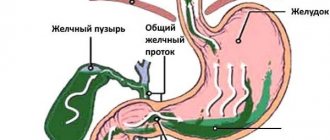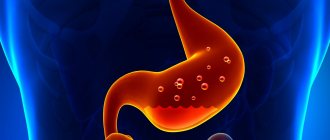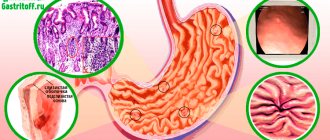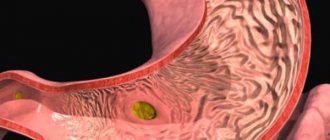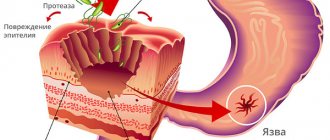Mixed gastritis is a disease that represents the simultaneous occurrence of several forms of gastritis - superficial, erosive, hypertrophic or hemorrhagic. This disorder often includes two to four forms. The main cause of the disease is considered to be the pathological influence of the bacterium Helicobacter pylori, on the basis of which characteristic symptoms begin to appear. This bacterium can be infected in several ways – fecal-oral or household contact. In addition, the causes of the disease may be poor nutrition and the use of certain medications.
- Etiology
- Varieties
- Symptoms
- Diagnostics
- Treatment
The main symptoms of a mixed type of disease are constant discomfort in the stomach, an increase in the size of the abdomen, nausea and vomiting, loss of appetite and belching. Diagnostic measures for such a disorder are complex. It is based on laboratory and instrumental examinations. Treatment consists of taking medications, following a special diet and using traditional medicine. A dietary menu is prepared individually.
Features of mixed gastritis
Mixed gastritis is classified into two forms:
- An acute form that develops from short-term exposure to irritating factors. In the absence of treatment, the pathological process progresses, and the formation of small bleeding erosion wounds begins on the affected areas of the mucosa. The disease becomes erosive. If therapy is not started in time, the pathology becomes chronic.
- The chronic form, which is characterized by stages of exacerbation and remission.
The course of the mixed form of gastritis is characterized by the dominance of any type of disease:
- when the superficial type of pathology predominates, the inflammatory process occurs in the upper layer of mucous tissue, without spreading to the deeper layers of the stomach walls. Most often it occurs without visible symptoms. The progression of the disease affects the glands of the stomach that produce hydrochloric acid. The functions of glandular cells are disrupted, acid production increases or decreases;
- the next stage of inflammation is atrophic gastritis, in which the number of gastric glands is significantly reduced and the pathology can become irreversible. The normal secretion of hydrochloric acid is disrupted;
- hemorrhagic mixed gastritis affects people who have thin blood vessels in the digestive organs. When mechanical or chemical damage to the gastric mucosa occurs, blood vessels rupture, minor or extensive bleeding occurs, and point erosions form at the site of the rupture;
- hypertrophic mixed gastritis is characterized by thickening of the walls of the gastric glands, on which cysts form over time. At an advanced stage of the pathology, formed cysts and thickened gastric walls are observed.
Types of disease
In medicine, there is a classification of types of mixed gastritis, and depending on the degree of damage, as well as symptoms, it is divided into the following types:
- Mixed chronic is the reason for untimely diagnosis and treatment of any other form of this disease. Chronic gastritis is not easy to cure and often makes itself felt throughout a person’s life, recurring most often in the autumn and spring. If you do not resort to adequate timely treatment of chronic gastritis, other inflammations may develop that disrupt the functioning of the gastrointestinal tract.
- Mixed superficial gastritis is the most common disease, and both adults and children can suffer from this disease. Superficial gastritis, detected at the initial stage, can be treated quite successfully, and if you seek qualified help in time, the prognosis for overcoming the disease is positive.
Atrophic form of the disease.
Mixed atrophic gastritis is manifested by erosive changes in the gastric mucosa, and special cells that produce secretions die. They do not have the ability to recover, which means that with such damage the organ loses its basic functions, simultaneously disrupting the normal functioning of all organs of the digestive system. Almost all forms of mixed gastritis are manifested by painful sensations in the abdomen, the appearance of heartburn, reflux, belching, and often due to painful sensations a person loses his appetite, which is a consequence of rapid weight loss.
https://youtu.be/ZhMtH0WXGqQ
Causes
The prerequisites for the development of mixed gastritis are the following factors:
- Infection with the bacterium Helicobacter pylori.
- Irregular, monotonous, unhealthy diet.
- Uncontrolled use of certain medications.
- Chemical damage to the gastric mucosa by acids, alkalis, poisons, and alcohol.
- Stressful state, long-term depression.
- Smoking.
- Alcohol abuse.
- Hereditary predisposition (the main factor in the development of pathology in children).
Summarizing
Mixed gastritis is a very “inconvenient” disease regarding diagnosis and treatment, causing significant discomfort to the patient. Therefore, it will be much better if the doctor identifies this pathology at an early stage of development. For this reason, experts recommend undergoing an annual preventive examination. Of great importance in the fight against mixed gastritis is the efforts of the patient himself. After all, dietary nutrition in a sense plays a more important role than drug treatment. In general, a lot in the patient’s condition depends on his eating behavior. Taking medications will be useless if the patient does not reconsider his diet.
Today, gastritis is a serious problem, as the number of patients with this disease is rapidly increasing. Not only adults and able-bodied people get sick, but also children and teenagers. What is mixed gastritis? This form of the disease is a combination of various types of inflammation of the epithelial lining of the stomach.
For mixed gastritis, a combination of erosive, superficial, hemorrhagic, and hypertrophic variants of the disease is typical. Usually one of the listed forms acts as the predominant one. Such combinations usually consist of 2, 3 and even 4 forms. The main provoking factor remains the bacterium Helicobacter pylori. Let's talk about mixed chronic gastritis: what it is, how it manifests itself and how it is treated.
Symptoms
Mixed gastritis has a variety of symptoms. The pathology can affect the upper layer of the mucosa with the formation of small erosions, occur with a decreased or increased level of acidity of gastric juice, spread to the entire mucous membrane of the organ or be localized in certain areas.
With mixed gastritis, the following main manifestations are observed:
- flatulence, bloating;
- a feeling of pain in the left hypochondrium, less often in the intestines (with concomitant bulbitis or duodenitis);
- discomfort and heaviness in the abdomen;
- constant feeling of hunger;
- severe fatigue, weakness;
- insomnia;
- apathy, depression;
- stool disorders (diarrhea gives way to constipation);
- poor appetite;
- nausea and vomiting (immediately after eating or after some time);
- unpleasant belching;
- symptoms of poisoning.
Diagnostics
The variety of clinical pictures and symptoms in some cases makes it difficult to diagnose mixed gastritis. In order to accurately establish the diagnosis, a comprehensive clinical and instrumental examination is carried out:
- Blood test (general and biochemical).
- Analysis of urine.
- A blood test that determines antibodies against Helicobacter pylori infection.
- Analysis of stool for the presence of the bacterium Helicobacter pylori.
- Respiratory test. Detects remnants of Helicobacter pylori in exhaled air.
- Fibroesophagogastroduodenoscopy. It determines the type of gastritis with great accuracy, for which a special probe is inserted into the stomach to see the condition of the mucous tissues of the organ.
- Probing. A scraping from the mucous tissue of the stomach and a sample of gastric juice are taken (to identify the causative agent of the disease).
Treatment of mixed gastritis
There are two treatment options for mixed gastritis:
- outpatient. The patient is examined in a medical facility, after which he is prescribed certain treatment at home. This treatment regimen is used when the condition is not critical and can be controlled with medications and a therapeutic diet;
- stationary. In severe cases, the patient may be hospitalized immediately after seeing a doctor. Typically, the course of treatment lasts two weeks, after which the patient is transferred to outpatient treatment.
The main goal of therapy for mixed gastritis is to restore the mucous membrane of the gastric walls and eliminate the harmful factors that provoke this gastropathology. Therefore, the disease should be treated comprehensively:
- Drug therapy.
- Following a therapeutic diet.
- Using traditional medicine methods.
- Physiotherapeutic procedures.
Drug treatment
Drug therapy for mixed gastritis is carried out with great caution, especially in the dosage form caused by taking medications. Treatment usually consists of a combination of the following medications:
| Group of drugs | Name |
| Antibiotics (if infection is present) |
|
| Antacids that normalize stomach acidity levels |
|
| Anti-inflammatory drugs that help stop the pathological process |
|
| Antispasmodics that relieve pain |
|
| Enzyme agents that control the level of enzyme formation |
|
| Proton pump inhibitors that reduce the secretion of hydrochloric acid |
|
Self-medication for mixed gastritis is not only ineffective, but also very dangerous. Only a gastroenterologist can correctly prescribe a treatment regimen. It is necessary to strictly follow the doctor’s recommendations to prevent chronicity of the disease or the development of complications and serious pathologies.
Diet
The diet for mixed gastritis depends on the level of stomach acidity. During the course of a disease with high acidity of gastric juice, you should eat foods that do not irritate the gastric mucosa, both thermally and chemically. The diet should be balanced and nutritious. It is recommended to exclude from the diet foods that are difficult to digest and corrode the gastric mucosa.
Dishes need to be steamed or boiled. You should limit your salt intake. Before going to bed, it is useful to drink a glass of milk with honey. It is good to include Borjomi mineral water in your therapeutic diet, which is consumed an hour before meals. The menu should consist of:
- mucous porridges;
- vegetable soups;
- minced meat dishes;
- boiled lean meat and fish;
- low-fat dairy products;
- berry and fruit jelly.
Nutrition for mixed gastritis with low acidity includes baked, fried without breading, containing fiber dishes. It is useful to drink natural fruit and berry juices, compotes and jelly. It is recommended to eat lean meats and fish, chicken, rabbit meat, and soups with meat broth.
At any level of stomach acidity, the following should be avoided:
- Fatty meats and fish.
- Sausages, smoked meats.
- Canned meat and fish.
- Mushrooms, legumes, cabbage, radishes.
- Sweet baked goods.
- Confectionery products.
- Chocolate.
- Spices and seasonings.
- Carbonated and alcoholic drinks.
Physiotherapy
Physiotherapy methods are usually used in the remission stage of chronic mixed gastritis. A number of procedures are prescribed:
- immunomodulation. Treatment procedures are carried out by the action of thermal low-frequency microwaves and laser quantum irradiation;
- magnetotherapy. With a targeted effect on the mucous tissues of the stomach, the condition of capillaries, metabolic processes, and microcirculation improves. In addition, swelling is reduced and the process of tissue regeneration starts;
- ultrasound. Helps relieve chronic pain;
- electrical stimulation, aerotherapy. Improves the functioning of the brain and nervous system;
- cryotherapy. Temperature effects relieve pain, swelling, activate the immune system;
- UHF. It has a mild effect of electric current and is prescribed even during exacerbations.
For mixed gastritis during remission, mud therapy is effective: applications and baths with therapeutic mud.
Folk remedies
When choosing traditional medicine methods, you must listen to the advice and recommendations of your doctor. Like medications, folk remedies can be potent and cause side effects and exacerbation of mixed gastritis. The main rule of using herbal medicine is regular use of the products according to the established scheme. The result will be noticeable at least a month after the start of treatment.
Some of the most effective and affordable recipes:
- If you have high acidity, it is useful to drink potato juice. In addition, the product relieves heartburn and nausea. Take ½ glass of fresh potato juice half an hour before meals.
- A decoction of calendula, plantain, St. John's wort and wormwood. Pour ½ liter of boiling water 1 tbsp. lie collection, leave for half an hour. Drink 100 ml of decoction half an hour before each meal.
- Medicinal tea. Take equal amounts of mint, plantain, cumin seeds and calamus. Place 1 tbsp in a thermos. lie collection and pour ½ liter of boiling water. Infuse the product for 10 hours.
- Natural honey helps relieve pain and inflammation and destroy bacteria. It can be used as a stand-alone remedy or added to herbal infusions, medicinal oils and juices. For high acidity, a very effective remedy made from honey, fresh aloe juice and butter is used.
- Propolis. The tincture is successfully used for any level of stomach acidity. If the secretion of gastric juice is increased, homemade tincture is mixed with milk. 50 g of propolis is poured with ½ liter of vodka or alcohol. Infuse in a dark place for 10 days. The tincture is also used with medicinal herbs and oils.
- Motherwort juice. Fresh juice from motherwort leaves is consumed in 1 tsp. before meals 3 times a day.
- Sea buckthorn oil has a protective effect on stomach tissue and replenishes vitamin deficiencies. The method of consuming the oil depends on the acidity of the stomach. When acidity is low, it is useful to drink tea and fruit juice made from fresh sea buckthorn.
- Calendula oil has an anti-inflammatory and disinfecting effect.
- Herbal infusions and teas from St. John's wort, celandine, and plantain are effective.
Prevention
To prevent the progression of mixed gastritis, you need to follow several simple preventive measures:
- observe the rules of sanitation and hygiene;
- monitor the quality of food consumed;
- maintain a healthy diet;
- stop smoking and drinking alcohol;
- avoid stress;
- exercise, walk more;
- promptly treat dental and gastrointestinal diseases;
- undergo regular medical examination.
Despite the fact that mixed gastritis is considered a fairly serious disease, it can be completely cured. At the first manifestations of pathology, you need to urgently contact a medical facility. If treatment is started in the early stages of the disease, it will be faster and more effective.
Preventive measures
The best way to get rid of a disease is to prevent it. This is an axiom that is often forgotten. It is enough to follow simple rules to avoid the development of the disease.
- Do not abuse alcohol.
- Maintain hygiene and be careful about the food on the table.
- Adhere to a proper diet: do not overeat or starve.
- If possible, avoid nervous tension, walk more and do as much physical exercise as possible.
- Undergo preventive examinations on time, do not wait for the slightest sign of pathology to appear.

